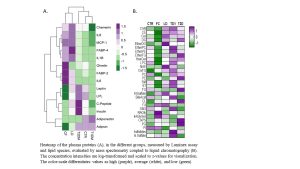Cystic Fibrosis (CF) primarily affects pancreas and lungs. Reduced lipids in plasma, their accumulation in peripheral organs, such as liver pancreas and the airways, and altered plasma concentration of adipokines characterize CF dyslipidemia. Pancreas deficiency contributes to CF related diabetes (CFRD), a major CF comorbidity. CF patients’ plasma lipidome, hormones and inflammatory markers were compared with diabetes patients (DM) or patients undergoing lung transplant for different lung diseases (LD). CF and LD exhibit a significant upregulation of inflammatory cytokines, with IL1b, IL6 and IL8 increasing versus healthy subjects (H) from 3 to higher than 10 folds, whereas DMType 2 upregulate the cytokines approximately 1,5 folds over H. Furthermore, hypoinsulinemia characterizes CF and DM type1 (peptide C 293 pg/ml in CF versus 692 pigr/ml in control). Unexpectedly, adipokines and lipids in CF plasma profoundly differ from both DM type1 and 2 (Fig. A and B). When comparing to H, CF showed 1.7 fold reduction of leptin and 2 fold increase of resistin, a 2,4 fold increase in plasma fatty acids (FA), up regulation of their transporters (FABP2 an FABP4, 4 and 5 folds respectively) and FA amides (N-acyl glycine, NAcGly 4 folds), in opposition to a reduction in FA esters (acyl carnitine, CAR 1,6 folds, 1,5 folds cholesterol esters CE), 2 fold decrease of lipoprotein lipase, overall reduction of most of glycerolipids and sphingolipids, with significant reduced levels of sphingomyelin (SM) and phosphatidylcholine(PC) and lsyoPC. Next, we compared lipid profile of lung biopsies derived from CF and LD patients. Most of the species that are decreased in CF plasma, are increased in their lung biopsies (SM, LysoPC and CAR). Importantly, the lipid content of extracellular vesicles (EVs) derived from plasma revealed a trend of increase in CF versus LD, similar to the biopsies. We speculate that C develop a reduced consume of lipids and lipids accumulation in peripheral organs, promoting reduced glucose entry, hyperglicemia, inflammation and insulin resistance. Plasma EVs may identify CF lipids alteration for the staging of the disease and lipid metabolism can be considered a therapeutic target.


